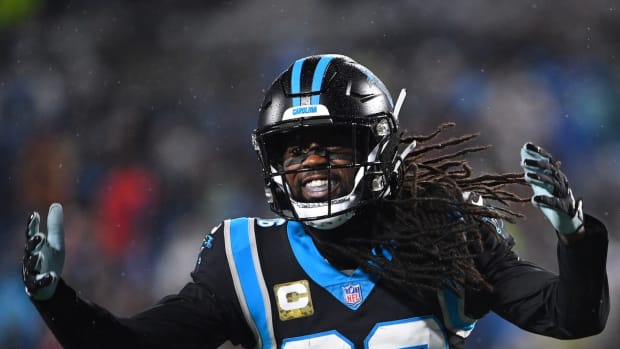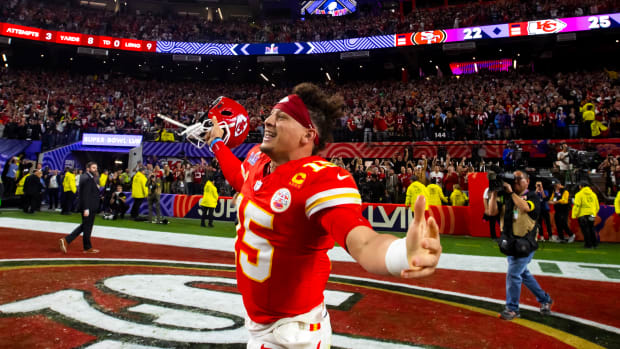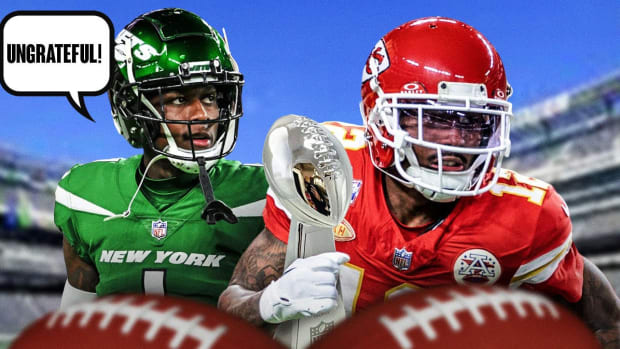Deshaun Watson, Alex Smith, and How College Spread QBs Can Work in the NFL
NFL teams have been trying to project quarterbacks from college spread offenses for over a decade now, and coaches have tried just about everything to make it work.
The Redskins imported the Baylor offense for Robert Griffin III, and the Niners brought in Nevada’s pistol for Colin Kaepernick. The Panthers built in spread concepts for Cam Newton, and the Broncos turned their offense upside-down to make it work, short-term, for Tim Tebow. There were fits and starts; some experiments worked while others didn’t.
And then came Sunday night’s Chiefs-Texans game, and it was all there for us to see.
On one side, one of the first college spread QBs to be drafted high—Kansas City’s Alex Smith—was playing in a classic pro-style offense that’s been radicalized over the last two years with all kinds of spread concepts that fit his skillset. On the other side, Houston rookie Deshaun Watson, just getting his feet wet, had his coaches doing all they could to put him in position to compete in his first NFL season. We saw the template for what the finished product should look like playing against the blueprint for how to get started.
“Teams are more open-minded to evaluating spread QBs, and they aren’t killing them as much based on the offense,” said one AFC college scouting director. “We still need arm strength, accuracy and good decision making. So the core traits we look for haven’t changed. I think it’s maybe causing some people to stop being so close-minded about the position, though.”
Before the season, we wrote about the rise and fall of the zone-read in the NFL, and how the option game has since settled into its place as a complementary element of the modern NFL offense. That, too, can explain how breaking a young quarterback into the league has changed over the years, with coaches as open as they’ve ever been to embracing the trickle-up of football schematics.
In this week’s draft column, we’ll take you through a couple coaching names to watch, another Bosa, why Saquon Barkley’s worst day was still a pretty good indicator for scouts, and which quarterback has a shot to become this year’s version of Mitchell Trubisky. But we’ll start with the question of the spread quarterback, and what that background means as far as having a long NFL career. Among this year’s presumed top quarterbacks, USC’s Sam Darnold, Oklahoma’s Baker Mayfield, Oklahoma State’s Mason Rudolph and Washington State’s Luke Falk come from schemes heavy on spread elements.
Pence, Powder and a Packer ‘Miracle’ in Dallas: NFL Week 5 Had It All, and Then Some
And, again, all the answers seemed to be there in plain sight in Houston on Sunday night. Want to take it to another level? Well, how about this: When Jordan Palmer, the man who trained Watson for the NFL draft, was asked by front-office types in March and April for a comp on the Clemson star, he never hesitated.
“Every single time I said Alex Smith,” Palmer said on Monday night. “They’re the same size, same speed, same quick release. Both have pretty strong arms, but not the strongest in the league. Neither guy is 6' 5", and both are really intelligent and phenomenal people. And they both came from productive spread offenses, and were runners up for the Heisman.
“The difference is, Alex is more polished mechanically, and Deshaun has no scars—he’s won big games, played great all the way through. Alex got beat up a little more.”
The evaluators who gave Sunday night’s game a look saw the same. Watson’s development is still very much a work-in-progress, and he’s showing a tendency to tuck it and run when he comes off his first read. His accuracy dissipates when he goes deeper into his progressions, and he put a lot of 50-50 balls up in the direction of DeAndre Hopkins, who was targeted on 12 of his 31 throws. There were some designed runs, and more rollouts off play-action to cut the field in half.
Bill O’Brien is now running a Texans offense this is, in essence, working to buy his quarterback time to develop as a pocket passer, which is still a necessary of part of the NFL game. And that’s where the evolution has to come for Watson. Palmer trusts it will, because of O’Brien, who was the reason why he and Watson “always wanted to get him to Houston.”
Smith knows what Watson’s about to go through, because he went through it big-time during his eight years as a Niner. Coming from Urban Meyer’s Utah spread, where he was an option quarterback, Smith had six offensive coordinators in his first six NFL seasons. Then Jim Harbaugh arrived, and OC Greg Olson installed spread elements to make the QB comfortable. Smith led San Francisco to an NFC title game appearance that year, before losing his job in 2012 to Colin Kaepernick, after which he was traded to the Chiefs.
By the time he dove into working with Andy Reid there, Smith had become a fully functioning pocket passer. And where Roman, Harbaugh and Co. used spread concepts to help facilitate that growth, Reid flipped it around and added spread concepts—thanks to ex-Nevada coach Chris Ault, who was hired as a consultant—to highlight Smith’s athleticism and supplement his more traditional system. The result has been perhaps the NFL’s toughest offense to game plan for and defend.
That brings us back to how this roadmap might affect the way the pros evaluate college quarterbacks. Consider what one veteran personnel director said over the phone, in referencing Watson’s fast start: “Maybe you’d shy away now from the QB you think has potential and go with the quarterback with a track record of success. Just look at the players that have had minimal success or experience in college compared to the players who had experience and success.”
In other words, maybe a team would be emboldened to take someone like Watson. The Texans sure are glad they were. And on Sunday night, they got a pretty good look at what happens once a player like that in the right situation could become down the line.
FIVE FROM SATURDAY
1. I’m going to go deeper on this at some point soon, but given how the churn of coaches has affected the NFL market, I have to wonder when some team makes a really hard run at Alabama’s Nick Saban, who’d re-enter the league with a much stronger reputation than he came in with in 2005. Yes, he’s 65—a few weeks younger than Pete Carroll and a few months older than Bill Belichick—but his ability to set up a program and build a staff should be attractive, and I don’t think there’s any reason he couldn’t coach until he’s 70. All you have to do is look at what the Tide is doing this year to see his energy for the job.
2. If you want a younger name than Saban, keep an eye on Vanderbilt’s 43-year-old coach Derek Mason, who served for a year under Jim Harbaugh and three under David Shaw at Stanford, and was the Vikings assistant defensive backs coach for three years on Brad Childress’ staff. Vanderbilt is a tough place to win, and this year hasn’t been the breakthrough that some expected, but there are NFL types that like him.
3. Nick Bosa, Joey Bosa’s little brother, is just a true sophomore at Ohio State, but he already has the look of a Top 10 pick—and he’s not even starting for the Buckeyes yet. Because Ohio State returned both its starters at defensive end, Bosa is coming off the bench, and he’s still posted four sacks. He was borderline unblockable against Maryland on Saturday.
4. The top player on our Big Board, Saquon Barkley, had a largely frustrating afternoon at Northwestern—the Wildcats were geared up to stop him and, for 42 minutes, pretty much did. At that point, the Heisman candidate had just 12 carries for four yards, and two catches for nine yards. But count what he did without the ball as another win for him. He protected, he worked as a decoy, and he set up quarterback Trace McSorley to control the game. It’s something scouts will take notice off. And the 53-yard touchdown he wound up scoring to salt things away late in the third quarter wasn’t bad either.
5. West Virginia lost to TCU, but junior receiver David Sills continues to be one of the better stories in the country. Long known for being the quarterback who committed to Lane Kiffin and USC as a seventh-grader, his winding road has led him to a second stint in Morgantown, this time as a receiver, and he had seven catches for 116 yards and two touchdowns against the Horned Frogs. The 6' 4", 203-pounder has now gone for over 100 yards in three of his last four games, with eight touchdowns in that stretch. Dana Holgerson sold him on coming back to WVU as a receiver by telling him he had an NFL future at the position.





































